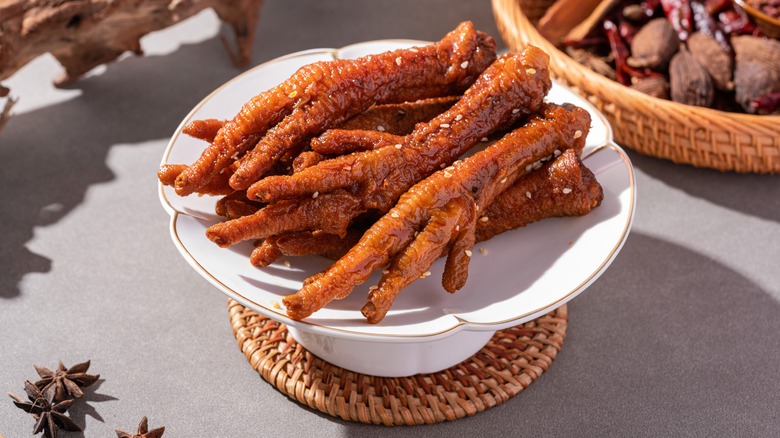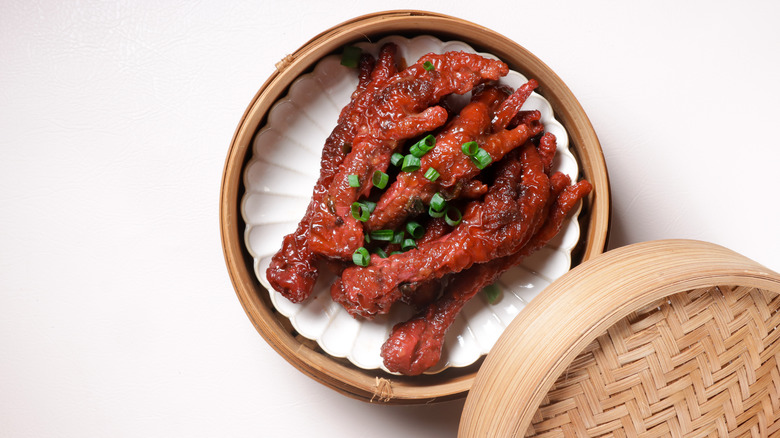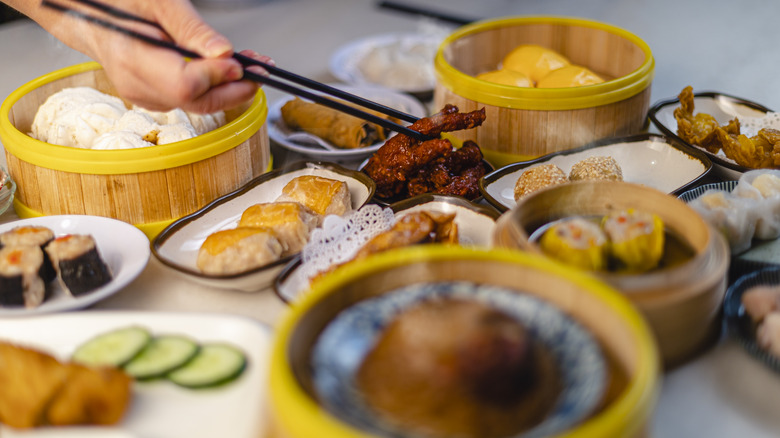How To Eat A Chicken Foot
Domestic chickens are the most populous bird in the world, having eclipsed 25 billion in 2023. However, depending on where you are on a map, some parts of the poultry are more in demand than others. In the United States, shoppers tend to favor the breast over the rest, according to Statista. Meanwhile, countries like China, Korea, the Philippines, Vietnam, and beyond prize an appendage that your average American butcher shop might not put on display — the feet.
Though they might look meaty, chicken feet are mainly an amalgam of skin, tendon, and bone. Known in China (and listed on your local dim sum menu) as "phoenix talons" or "phoenix claws," they have a unique gelatinous texture or kou gan, that makes them well-suited to flavorful sauces. As for the flavor without sauce, it's decidedly more subtle (less chicken-y, if you will) than other parts of the bird.
While guiding a reticent writer for The Guardian through a dim sum feast that included chicken feet, the British food historian and chicken feet enthusiast Fuschia Dunlop (whose book "Invitation to a Banquet" explores the sprawling history of Chinese food through some of the country's landmark dishes) gave the following advice: "Try to feel them as well as taste them." As Dunlop knows, the preparations and occasions for eating chicken feet are as varied as any other part of the bird. Indeed, they've been eaten in China since at least the third century B.C.
Blanched, fried, and sauced
Dim sum restaurants are by no means the only establishments that serve chicken feet in the U.S., but they're a great place to learn about a common three-step method of cooking the appendage, which is nearly ubiquitous in Cantonese dining. One thing's for sure: Prepping chicken feet this way takes time and skill.
Typically, the first step professionals take is to blanch the feet and prepare them for frying by trimming the nails and drying the skin. Only then are they ladled into a wok of hot oil and cooked until they're golden brown. A quick cold water bath allows their skin to contract into the coveted wrinkly texture called "fu pei," or "tiger skin." Before serving, the cooked feet are simmered briefly in stir-fried aromatics and a flavorful condiment, such as fermented black bean sauce.
Whatever you do, don't skip the blanching. This crucial step not only partially cooks the chicken and helps remove bacteria and other impurities from the raw skin, but it also helps tenderize the cartilage and skin, leading to that signature silky texture.
Leave the fork (and the bones) behind
When it comes time to tuck into a plate of chicken feet, chopsticks or your hands are your best tools. "There's a sort of primal satisfaction that comes from eating a chicken foot — biting around for the knuckle, pinching off a joint with your incisors, sucking ferociously at what little cartilage, skin, and sauce can exist on a centimeter-long segment of chicken toe," wrote Kalos K. Chu in an essay for the Harvard Crimson, which is as visceral as it is edifying. Indeed, many people start by chewing between the toe joints and working their way up.
Most places will remove the nails before cooking, but if you happen to come across one, don't eat it. Ditto with the bones, which, though perfect vessels for holding tiny amounts of sauce, should not be swallowed. As Fuschia Dunlop puts it, "You can take out the bones or gently spit them out, so you don't have to be anxious about being rude." The cartilage and skin, on the other hand, are up for grabs. The small pad of the underside of the foot contains the most flesh and is sure to be all the more delectable for it.


